 Happy 2020 to all. Staten Island Chuck has predicted an early spring. This year either we will get rid of our treasonous, impeached president or U.S. democracy will die a sorry death. On those notes, after a much-needed hiatus we resume our normal production schedule for posts here at the blog.
Happy 2020 to all. Staten Island Chuck has predicted an early spring. This year either we will get rid of our treasonous, impeached president or U.S. democracy will die a sorry death. On those notes, after a much-needed hiatus we resume our normal production schedule for posts here at the blog.
•
As noted in a previous post, the proposal for my September-October Teti Photography Fellowship at the Institute of Art and Design at New England College, in Manchester, NH, included working on my main current project, “Alternate History: Robert Capa on D-Day.”
In this regard, my most pressing need involved the thorough rewriting of the early drafts of the opening chapters of the book in progress, which distills the past five years’ worth of research. The surprising results of our team’s most recent research efforts required radical reconstruction of those chapters. This in turn made it important for me to have a space and time outside my usual workplace and routine, in order to concentrate on this retelling of the narrative.
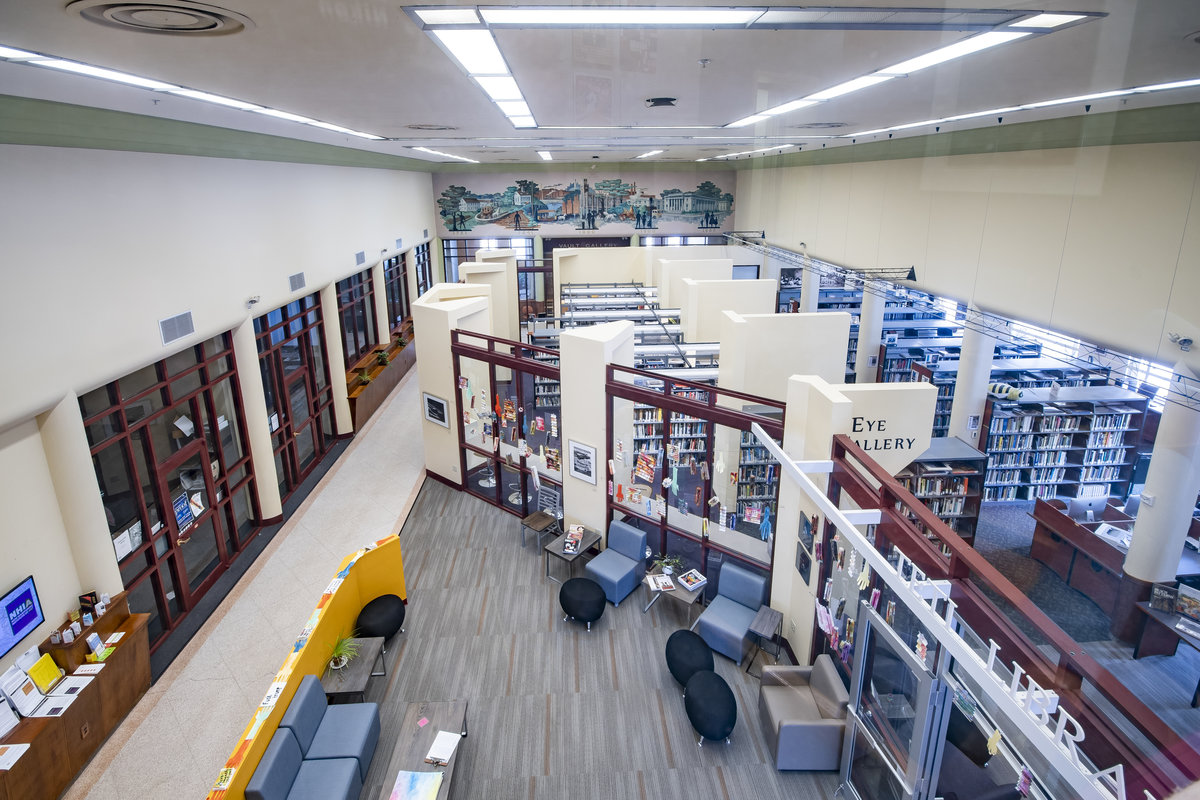
Fuller Hall Library (interior view), Institute of Art & Design at New England College
The quiet of the library and solitude of its Special Collections room provided exactly the work environment necessary for that task. The presence in the collection of a number of books by or about Capa specifically (including the first edition of his 1947 memoir, Slightly Out of Focus), as well as books on photojournalism in general, proved extremely useful. I also located one highly relevant item in the collection — a memorial tribute to Capa published shortly after his death in the U.S. Camera Annual 1955 — with which I had no previous familiarity. This discovery plays a role in my examination of the making of this myth. (More on that shortly.)
 As a result, I achieved a successful revamping of those chapters, which I believe will greatly assist me in identifying a suitable publisher for the book down the line. This project was also the subject of the lecture that I gave at the school on September 19, in conjunction with my fellowship. (For the reasons just indicated, I rewrote the text of that lecture to incorporate the latest research results, and revised considerably the accompanying Keynote presentation, during the first week of my residency.)
As a result, I achieved a successful revamping of those chapters, which I believe will greatly assist me in identifying a suitable publisher for the book down the line. This project was also the subject of the lecture that I gave at the school on September 19, in conjunction with my fellowship. (For the reasons just indicated, I rewrote the text of that lecture to incorporate the latest research results, and revised considerably the accompanying Keynote presentation, during the first week of my residency.)
•
As the evidence shows, Robert Capa began to fictionalize and exaggerate his D-Day experiences almost immediately upon his June 7, 1944 return to Normandy, starting with his June 9 interview with LIFE senior correspondent and bureau chief Charles Christian Wertenbaker. (Along with Ernie Pyle and Capa, Wertenbaker had come to cover the Allied advance on Cherbourg.) This characteristically self-deprecating (and tacitly self-glorifying) interview may not have included any description of a darkroom disaster; at that moment, as I wrote in an earlier post, “Capa had apparently not heard from Morris, nor from Hicks in New York; he had no idea what pictures had survived the trip to London, nor which ones Hicks had selected for LIFE‘s D-Day issue, nor how Hicks felt about them.”
Highly unlikely, then, that he told that tale to Wertenbaker immediately rather than later that summer — especially because, even if he already had it in mind in early June, he needed John Morris’s crucial complicity as verification. He certainly could not afford to have Wertenbaker return to London before he got there himself and ask Morris about it, only to get a “What darkroom disaster? What lost negatives?” in response. Implicitly, if not explicitly, the original account of this supposed loss had to have come from this assistant picture editor.
 Yet the seed of the myth of Capa’s “lost” negatives had already begun to germinate. According to a letter home from him to his mother Julia and younger brother Cornell (held in the International Center of Photography’s Capa Archive), postmarked as received in New York on July 19, 1944 but almost certainly written weeks earlier, apparently before he returned to London,
Yet the seed of the myth of Capa’s “lost” negatives had already begun to germinate. According to a letter home from him to his mother Julia and younger brother Cornell (held in the International Center of Photography’s Capa Archive), postmarked as received in New York on July 19, 1944 but almost certainly written weeks earlier, apparently before he returned to London,
“I also received a cable from [LIFE editor Wilson] Hicks saying that I was the best of the invasion even if most of my pictures were lost and ruined by seawater. … Cornell please write how my pictures were, I do not know what I was taking, what got lost and how are the ones which were printed.”
In a follow-up letter home, this one addressed to Cornell and his wife Edith, also in the ICP’s Capa Archive and annotated as received that same July, Capa wrote,
“Dear Edith and Cornell: … I just got back from London where I had a good time and a bad surprise. I found out that 90% of my invasion material was ruined by drying and the little which got printed is nothing compared to the material which they got ruined.”
Capa would not have seen the LIFE D-Day issue until several weeks after June 6, and on June 9, the date of his Wertenbaker interview, would have had no idea which of his images appeared in that feature story. But Wertenbaker, based in London and working on a quickie book about the invasion that he would publish in September 1944, conducted that interview while visiting the front shortly after the invasion began. So, if not on June 9, then sometime between then and early August at the latest, when Wertenbaker would have had to conclude his work on the manuscript and let it enter his publishers’ production pipeline, Capa certainly told his esteemed colleague the evolving fable of the darkroom disaster and the supposed loss of multiple rolls of his film of the June 6 landing on Omaha Beach. By that time he would have enlisted Morris’s endorsement of this fiction.
As a result, Wertenbaker would include in his book Invasion! the following (in his own words, after an extensive quote from his June 9 interview with Capa):
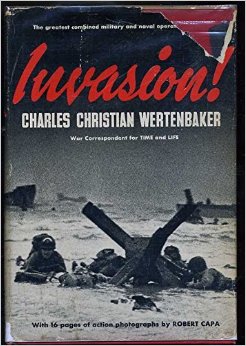
Charles Wertenbaker, “Invasion!” (1944), cover
“Bob Capa had taken 79 pictures of the fighting on the beach. They were the only complete photographic record of the worst hours of the invasion. A careless dark-room assistant ruined all but seven of them.” (P. 44. Note that at this point Capa claimed to have exposed only two rolls of 35mm film on Easy Red, while simultaneously and contradictorily asserting that “I shoot for an hour and a half and then all my film is used up.”)
Presumably, with Wertenbaker and others thereafter, Capa transmitted this fiction orally, in his role as an engaging raconteur. So far, I have not managed to find any other printed or otherwise publicly recorded version of the emulsion-melt fiction prior to its dramatic appearance as the climactic moment of the D-Day chapter in Capa’s 1947 memoir, Slightly Out of Focus. (The only partial exception to date: indication of a different form of processing accident — overheated darkroom chemistry — in John McNamara’s early 1945 book for young adults, Extra! U.S. War Correspondents in Action, the story sourced not to Morris but to Capa’s younger brother Cornell.)
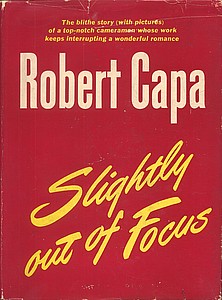
Robert Capa, “Slightly Out of Focus” (1947), cover.
Before Slightly Out of Focus came out, then, it seems safe to assume that the false narrative of the darkroom disaster circulated primarily by word of mouth, and only among those who knew the gregarious Capa personally — admittedly a wide circle, and not restricted to professionals in photojournalism: it included Ernest Hemingway, Ingrid Bergman, Irwin Shaw, and other notables, to name just a few. Still, it represents a relatively small group, with only a few of whom John Morris shared more than a passing acquaintance, and in whose social company Morris rarely found himself except at large parties Capa organized.
This matters because it indicates that, prior at least to the publication of Slightly Out of Focus, the very lack of evidence suggests that Morris rarely if ever got called upon to corroborate Capa’s tall tale in any social or professional conversational situation, and never in print. Indeed, we can’t ascertain whether or not he even proved complicitous by his silence on any occasion when Capa recounted his version of those events in this LIFE underling’s presence.
•
I can’t determine the exact dynamic of Morris’s relationship to the older Capa. Morris referred to Robert as “my adopted/Hungarian brother,” and obviously looked up to him. Whether his idol reciprocated that fraternal feeling, or simply saw Morris as just another member of his extended professional circle, remains unclear. (For whatever it’s worth, despite the fact that Morris and his first wife knew not only Robert but Cornell and their mother Julia, and — by Morris’s account — had dined and partied frequently at the family’s Manhattan apartment, the few examples of Robert’s surviving letters home that I have seen in the Capa Archives at the International Center of Photography do not mention Morris.)
Yet even if Capa saw Morris as merely another LIFE desk jockey, with minimal authority and wet behind the ears at that, it seems reasonable to assume that Capa would have informed Morris early on of his intention to concoct and disseminate the darkroom-disaster fable. He would have done so not only out of courtesy but because, as the necessary eyewitness to that calamity, Morris needed advance notice of this plan in case some situation required him to back up Capa’s account.
Morris would also have needed some detailed version of the event as it supposedly transpired in LIFE‘s London darkroom on the evening of June 7, 1944. He may not have known how Capa would eventually elaborate this story — so far as I can tell, the drying-cabinet/melted-emulsion specifics appear nowhere prior to publication of Slightly Out of Focus — but surely he had forewarning that his good friend’s radical revision of the facts of the matter implicated him as the first-hand observer who could verify this tragic loss of irreplaceable images, fleshing out Capa’s sketch to make it plausible (at least on first hearing). If so, they would have worked all that out either during Capa’s first post-D-Day return trip to London in early July or else during Morris’s brief visit to the French front later that month.
•
Here is that first telling in Capa’s own words, from Slightly Out of Focus:
“Seven days later I learned that the pictures I had taken on ‘Easy Red’ were the best of the invasion. But the excited darkroom assistant, while drying the negatives, had turned on too much heat and the emulsions had melted and run down before the eyes of the London office. Out of one hundred and six pictures in all, only eight [sic] were salvaged. The captions under the heat-blurred pictures read that Capa’s hands were badly shaking.”
If no previous situation had forced Morris to underwrite Capa’s fiction, especially in print, then the appearance of Slightly Out of Focus in fall 1947 effectively put Morris on the spot; thereafter, if asked, he could either confirm Capa’s fish story or contradict it. Fortunately for him, the question appears never to have arisen at the time, at least not on the record. The book itself met with a lukewarm critical response, enjoyed only moderate sales results, and sank like a stone amid the hundreds of other published WWII novels and memoirs. This particular anecdote drew no attention from its few reviewers.
(Notably, in the only recording we have of Capa speaking — during an appearance promoting that book on October 20, 1947 on the 8:30 AM morning New York radio show “Hi! Jinx” — his hosts, the husband-and-wife team of Jinx Falkenburg and Tex McCrary, ask Capa about his 1937 “Falling Soldier” image from the Spanish Civil War, which gets no mention in the memoir, but nothing about his D-Day experiences and the supposedly lost negatives, which sit at the center of that narrative.)
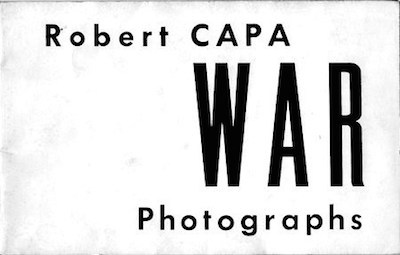
“Robert Capa: War Photographs,” catalog (1960), front cover
Hollywood, to whom Capa had hoped to sell Slightly Out of Focus as a film treatment, expressed no interest. Thus the melodramatic moment therein of the emulsion dripping off the film in the drying cabinet never made it to the silver screen, nor did it embed itself in public consciousness. It would not become umbilically connected to Capa’s D-Day images, and to Capa himself, until the touring Capa exhibition initiated by Cornell began to circulate widely in 1960, joined in 1964 by the monograph Images of War, with the darkroom fiction front and center in both as large-print caption material.
•
Does that represent the point at which Morris had to decide whether to fish or cut bait, and opted to publicly perpetuate the lie? As it turns out, he actually began that process several years earlier — in mid-1954. As I discovered during my time in the Teti Library, in the 1955 edition of the U.S. Camera annual, among the captions to a portfolio commemorating Capa published shortly after his death in Indochina, we find this annotating a reproduction of “The Face in the Surf”:
“Landing on D-Day with the first wave of American troops to hit ‘Easy Red’ beach in Normandy, Capa went through a hellish six hours[!], wound up an exhaustion case. He made a tremendous series of shots including this one of a rifleman in the surf (opposite, below). But an excited darkroom assistant ruined all but 8 of his irreplaceable negatives.”
This feature in the annual, which also includes an obituary for Werner Bischof (who died on assignment in Peru a few days before Capa), appeared with the approval of Magnum Photos, the picture agency that Capa had founded in 1947 and of which both he and Bischof were members. The unsigned accompanying articles profiling these two photojournalists may have come from the pen of the annual’s editor, Thomas J. Maloney, though he would most likely have merely tinkered with press releases provided by Magnum, for which Morris then served as “Executive Editor,” in which role he would have drafted them. The captions for the photos almost certainly came directly from Morris.
These annuals (of which the Teti collection holds a full run), published by the company that put out the newsstand monthly U.S. Camera, appeared early in the year of their cover dates, gathering material submitted and culled during the previous year. (Hence material from late 1953 through late 1954 comprised the 1955 edition.) Given the timeline of production for editing, writing, designing, printing, binding, and distribution of the annuals, in order to get them out early the next year, the Capa/Bischof material had to be in place by — my educated guess here — November 1 of 1954. So, sometime between the deaths of his two colleagues in May of that year and the fall deadline for the annual, Morris went all in on the Capa D-Day myth.
This U.S. Camera Annual article and its captions may not bear his byline, but they have his official imprimatur (not to mention Magnum’s). Absent the discovery of any earlier publication for which we can hold him responsible, then, we can date Morris’s active involvement in generating the Capa D-Day myth to sometime during the summer or fall of 1954, preceded by ten years of passive complicity.
•
Other such published accounts from Morris may have followed soon thereafter, and some may even have preceded this one; if so, I have yet to turn them up. Be that as it may, at that point, as one of the two main standard bearers for the myth (Cornell of course the other), he had to concoct a purely imaginary first-person eyewitness story that would flesh out what Capa had sketched in a few lines in his memoir and Morris had parroted in that caption.
It didn’t help that, as Morris himself would later acknowledge,
“I am not a darkroom technician — in fact I have never developed a roll of film in my entire life. My time in darkrooms, and I speak of LIFE‘s darkrooms in Chicago, New York, Los Angeles, London and Paris, was to either deliver film or to pick up prints, or perhaps to write captions.” (See Morris’s 2014 response to this investigation, “The A. D. Coleman Affair,” available here as a PDF download.)
 This explains the fact that what he cooked up as an elaborate cover story for Capa’s less detailed fabrication makes no sense whatsoever from a technical standpoint. The initially slow but eventually viral spread of the Capa D-Day myth sparked by the 1960 touring show and then the accompanying catalogue/monograph inevitably led to demand for a first-person, horse’s-mouth account of that disastrous loss. Only someone entirely ignorant of basic darkroom procedures could have unquestioningly accepted and perpetuated this farcical scenario — though, in all fairness, Morris had no choice but to incorporate Capa’s highly cinematic but logically impossible outline as the framework for his own, more detailed fabulation. Whatever discomfort the subsequent decades of lying would cause him, the underlying motive had nothing selfless about it, but instead the recognition that burnishing the Capa myth nurtured his own.
This explains the fact that what he cooked up as an elaborate cover story for Capa’s less detailed fabrication makes no sense whatsoever from a technical standpoint. The initially slow but eventually viral spread of the Capa D-Day myth sparked by the 1960 touring show and then the accompanying catalogue/monograph inevitably led to demand for a first-person, horse’s-mouth account of that disastrous loss. Only someone entirely ignorant of basic darkroom procedures could have unquestioningly accepted and perpetuated this farcical scenario — though, in all fairness, Morris had no choice but to incorporate Capa’s highly cinematic but logically impossible outline as the framework for his own, more detailed fabulation. Whatever discomfort the subsequent decades of lying would cause him, the underlying motive had nothing selfless about it, but instead the recognition that burnishing the Capa myth nurtured his own.
•
This post sponsored by a donation from Carlyle T.
•
Special offer: If you want me to either continue pursuing a particular subject or give you a break and (for one post) write on a topic — my choice — other than the current main story, make a donation of $50 via the PayPal widget below, indicating your preference in a note accompanying your donation. I’ll credit you as that new post’s sponsor, and link to a website of your choosing.
 Include a note with your snail-mail address (or email it to me separately) and I’ll include three (3!) copies of The Silent Strength of Liu Xia, the catalog of the 2012-13 touring exhibition of photos by the dissident Chinese photographer, artist, and poet, who, after eight years of extralegal house arrest in Beijing, finally got released and expatriated to Germany in 2018. The only publication of her photographic work, it includes all 26 images in the exhibition, plus another 14 from the same series, along with essays by Guy Sorman, Andrew Nathan, and Cui Weiping, professor at the Beijing Film Academy. Keep one for yourself, share the others with friends.
Include a note with your snail-mail address (or email it to me separately) and I’ll include three (3!) copies of The Silent Strength of Liu Xia, the catalog of the 2012-13 touring exhibition of photos by the dissident Chinese photographer, artist, and poet, who, after eight years of extralegal house arrest in Beijing, finally got released and expatriated to Germany in 2018. The only publication of her photographic work, it includes all 26 images in the exhibition, plus another 14 from the same series, along with essays by Guy Sorman, Andrew Nathan, and Cui Weiping, professor at the Beijing Film Academy. Keep one for yourself, share the others with friends.

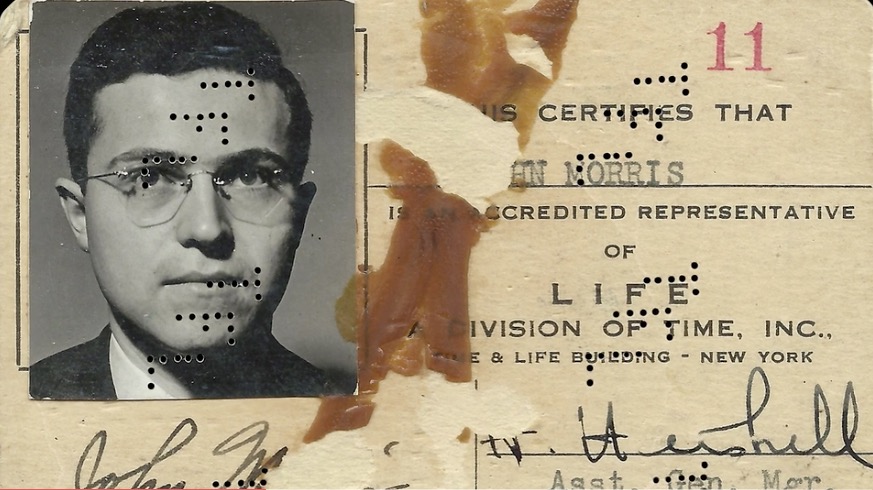
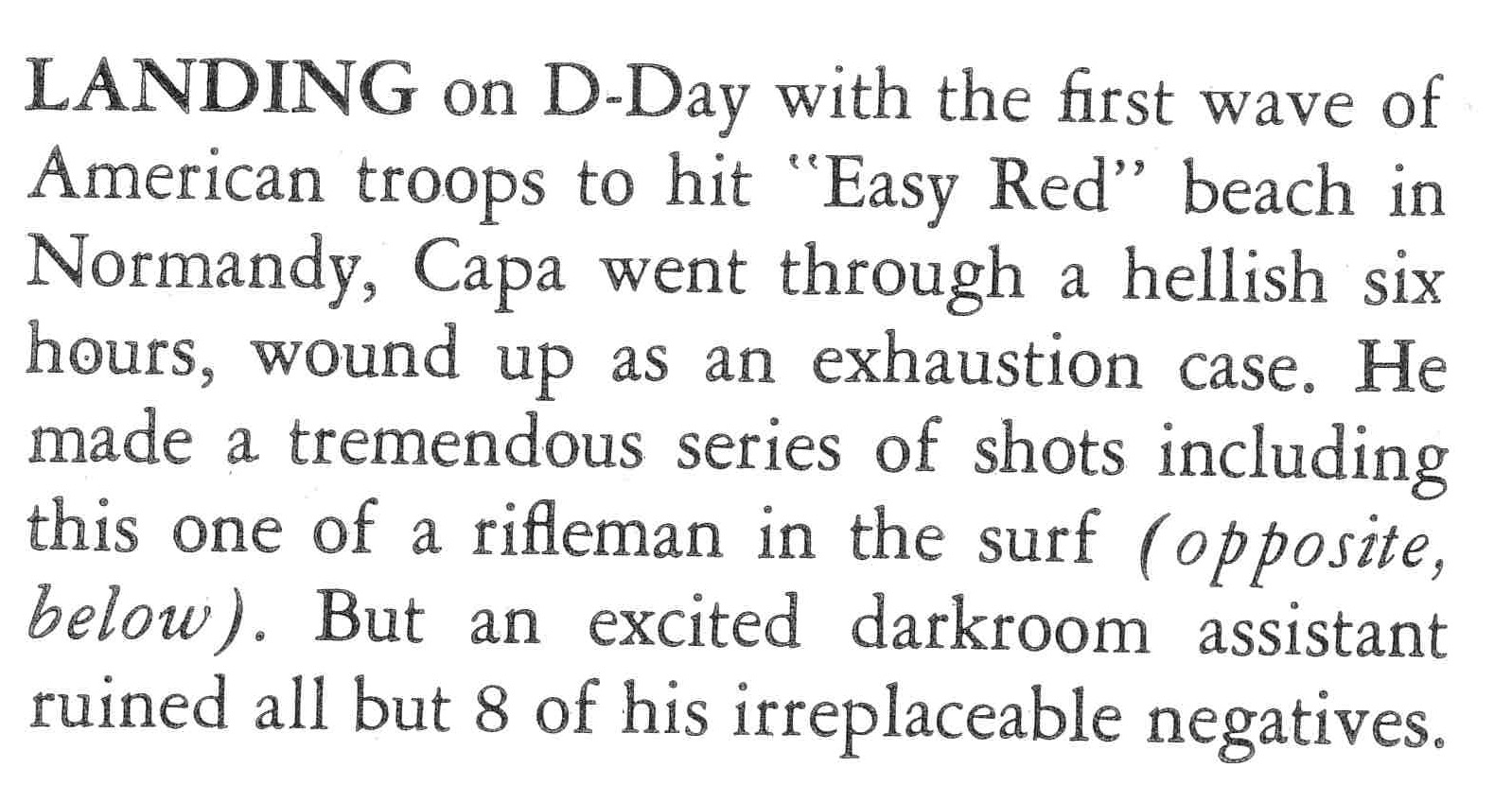
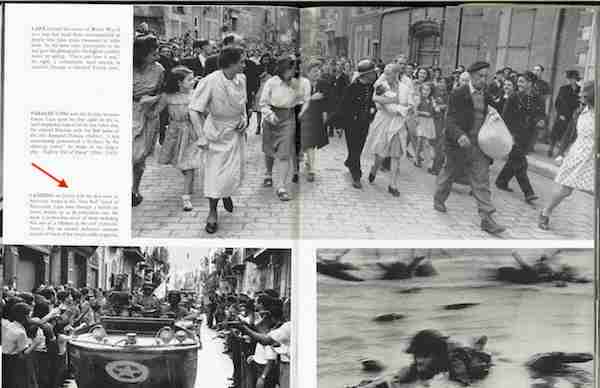
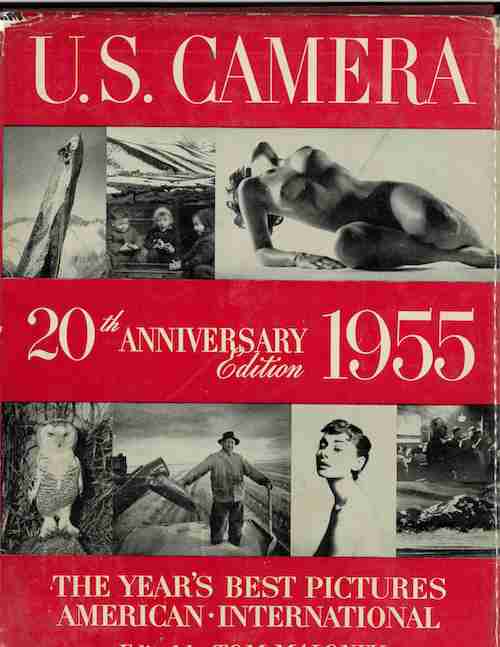




Has anyone tried to replicate the “melting emulsion” phenomenon? My son loves a program called “Myth Busters”; maybe we need to call them in on this?
Actually, I did try this, early on in the project — without success in affecting the film at all.
Since the Occam’s-razor explanation for the missing negatives involves censorship by SHAEF in support of the Fortitude South deception, and since neither I nor any of the experts on old films and chemistries I consulted could find other recorded examples of such a disaster (or even find it plausible from a technical standpoint), and since it’s based on the utterly implausible premise that (according to John Morris) in LIFE‘s London darkroom “the doors of the film-drying cabinet were normally kept open,” I see absolutely no reason to give this nonsense any credence or waste any more time trying to prove or disprove it.
Let’s just acknowledge our embarrassment at having bought it uncritically for so long, and move on.
I rather like to imagine the story eventually expanding to “Capa spent 6 gruelling months at Easy Red, shooting 100 millions rolls of film before old age forced him back to the landing craft, the ship, and thence to London, where an excited railroad engineer derailing the 300 boxcars of film, ruined all but 8 negatives”
It is genuinely hilarious to watch his time on the beach, and the number of negatives, expand.
One could take the opposite tack, and plot the various numbers and the linearly regress back to the day of the invasion to determine that Capa had in fact spent less that zero time on the beach, during which time he actually managed, somehow, to unexpose quite a lot of previously exposed film.
That’s the earliest version of the story from Morris that I have found to date, and the one that puts Capa on Omaha Beach for the longest stretch of time. How Morris came up with six hours I have no idea; maybe he folded in the time spent on the transports getting to and from Easy Red from the Chase, say three hours total, which would leave Capa on the beach for three hours.
Did Capa tell his brother Cornell and Morris the truth about his Normandy experience? In other words, did they know they were peddling lies when they repeated and embroidered that part of the fabulation? Or did they believe it? I don’t know — at least not yet. This year I plan to plunge into the Capa/Whelan papers in the ICP archives, and also to visit the Morris papers at the University of Chicago. The answers may lie there. Or we may never know.